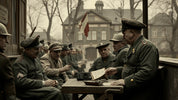
Exploring Daily Life in Nazi Germany: A Historical Perspective
, by Unboxify, 3 min reading time

, by Unboxify, 3 min reading time
Imagining daily life in Nazi Germany between 1933 and 1945 often invokes visions of a bleak and oppressive totalitarian regime. This was indeed the reality for many, particularly those who did not meet Hitler's Aryan ideals. To understand the full scope of life during this period, it's essential to examine both the experiences of the oppressed minorities and the general populace.
Jewish citizens faced brutal repression immediately after Hitler rose to power in 1933. Jewish civil servants, including teachers, professors, engineers, and administrators, were excluded from government employment within the first few months. "Kristallnacht," or "Crystal Night," saw thousands of Jewish businesses, homes, and synagogues destroyed, with Jewish citizens beaten and arrested. By 1941, most of the remaining Jewish population, nearly half a million strong in 1931, were imprisoned in concentration camps.
Other MinoritiesGypsies, homosexuals, Jehovah's Witnesses, and ethnic Slavs also faced severe persecution. Forced sterilization targeted these "undesirable" groups to prevent them from reproducing. Eugenics programs led to the euthanasia of up to 100,000 Germans, including 20,000 children, deemed "unworthy of life" between 1939 and 1941.
While men’s societal roles remained largely unchanged, women experienced significant shifts. Nazi ideology imposed traditional values on women, emphasizing modesty, dedication to Nazified Christian values, and, crucially, childbearing. A German Mother's Cross honored women who bore at least four children, reinforcing the importance of expanding the German nation.
The Nazis leveraged the education system to indoctrinate youth with their ideology. Curriculums promoted racial discrimination and discouraged mixing. Richard Evans notes that teachers and students began and ended lessons with Nazi salutes and that students frequently listened to political speeches.
Hitler Youth and League of German GirlsOrganizations like the Hitler Youth and the League of German Girls prepared boys for military service and girls for motherhood, integrating over 90 percent of Germany's children by 1939.
This state-sponsored initiative aimed to unite Germany’s Protestant churches under a national church supporting the Nazi agenda. Propaganda Minister Joseph Goebbels distributed millions of inexpensive radios to disseminate political messages, although many Germans simply wanted to carry on with their daily lives.
Enforcing the Ideal StateRealizing that indoctrination only went so far, the regime enforced its vision through legislation. Men and women aged 19 to 25 had to undertake a six-month public labor tour. Women could return home afterward, but men were conscripted into the Wehrmacht, reinforcing the labor and military force.
By 1933, unemployment in Germany stood at 35 percent, and inflation was rampant. The Nazi promise to restore the economy won them significant electoral support. Public works projects, like the Autobahn, aimed to reduce unemployment.
Economic Impact ExaggerationsThough many reports of economic improvement excluded Jews and soldiers, the reforms eventually stabilized unemployment rates. Yet, despite promises of peace, Hitler plunged Germany into another devastating war.
To sustain German military expansion, new regions were continually conquered, escalating the conflict to a global scale. The Eastern Front alone saw overwhelming casualties, shattering any hope for the utopian society the Nazis envisioned.
The AftermathDefeat led to a divided Germany that would not reunify until 1990, taking nearly a half-century for normalcy to return.
One of the many intellectuals who fled during this time was Albert Einstein. His legacy continues to influence today's problem-solving methodologies.
Expressions of RemembranceThe period of Nazi Germany serves as a critical historical lesson on the dangers of unchecked power and ideologically driven oppression. As time progresses, it remains essential to remember and understand these events to prevent such atrocities from recurring.
If you are interested in delving deeper into this era's history, explore topics like the rise of Prussia and the Prussian army to gain a more comprehensive understanding of German history.